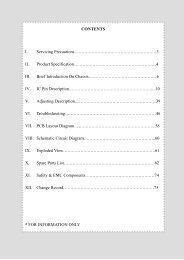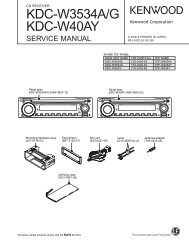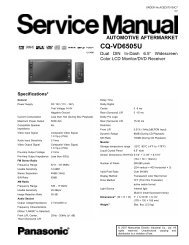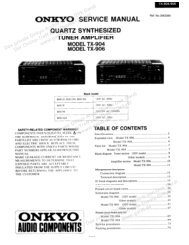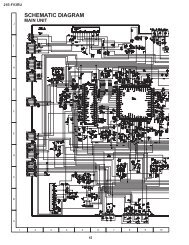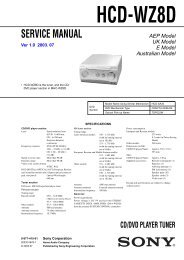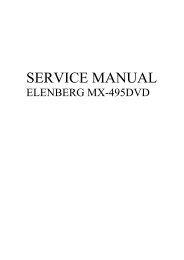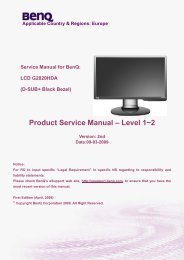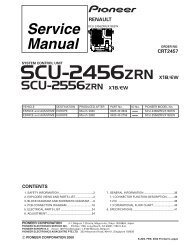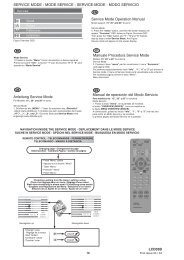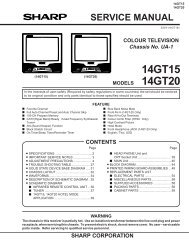Technology of Q 2500 colour TV set
Technology of Q 2500 colour TV set
Technology of Q 2500 colour TV set
Create successful ePaper yourself
Turn your PDF publications into a flip-book with our unique Google optimized e-Paper software.
<strong>Technology</strong> <strong>of</strong> Q <strong>2500</strong> <strong>colour</strong> <strong>TV</strong> <strong>set</strong>Changes to these values will be communicatedvia the I²C bus to the appropriate processorsduring the adjustment procedure andcan then be adjusted to the required values.All data read in on start up as well as datachanged by the customer during operation, ischecked during operation by continuouscommunication between the SDA 6000 andthe signal processors. If deviations occurthese are corrected immediately.This is particularly the case for timedependenttuning values such as, for example,white value, black value and c.r.t. leakagecurrent. For this reason in devices incorporatingthe Q <strong>2500</strong> chassis, ageing <strong>of</strong>, forexample, the c.r.t. only becomes apparentwhen the scope <strong>of</strong> control is exhausted andthe c.r.t. is totally worn out. In our chassisthese dynamic tuning values are thereforesubject to special treatment. The values forthese functions held in the memory are automaticallyupdated to the current values oneach save procedure. In this way updating <strong>of</strong>the current wear-determined values on startup is not necessary, which the end user willsurely notice.For control and adjustment procedures via theremote control and local operating buttons thechanges are initially made only in the workingmemories <strong>of</strong> the appropriate IC’s and in theregister <strong>of</strong> the SDA 6000. Normally the saving<strong>of</strong> values in EAROM must be implemented byan additional command (usually the OK button).If the remote control is used to switch thedevice to standby, then the data in the register<strong>of</strong> the SDA 6000 is available when the unit isrestarted. The data within the unit, such as thelast volume level <strong>set</strong> is retained.When the unit is switched <strong>of</strong>f at the mains themicroprocessor register is deleted, and on thenext start up only the EAROM data is available.So that specific <strong>set</strong>tings are retained, theEAROM has an area for “Last memory“ data.On shut down the data is saved to this area(e.g. last programme location). In addition, afew seconds after programme location changethe <strong>set</strong> programme location is saved in theLast Memory data area.4.2.10 Service modeIn order to carry out chassis tuning the devicemust be placed in the required service mode.The remote control can then be used to callup all the necessary functions for chassis tuning,with a few exceptions. After successfultuning the new values must be saved.The exact functions available in the servicemode can be found in the service instructionsfor the appropriate device.4.2.11 Video textIn the 100Hz <strong>TV</strong> <strong>set</strong> system the videotextfunction and the production <strong>of</strong> overwritingOSD is now the responsibility <strong>of</strong> the CCU SDA6000.For this reason the FBAS signal is fed to pin117 <strong>of</strong> the CCU. The CCU controls full dataseparation and memory administration internally.The VT pages are then stored in theSDRAM I 2916.The VT information as also the OSD overwritingare applied to pins 112/113/114 <strong>of</strong> theCCU as RGB signals.4.2.12 Picture signal processingPicture signal processing is implemented byhighly integrated modern circuits that havebeen used for the first time by Loewe, in similarIC variants, in the Q 2300 chassis generation.The highly integrated IC’s mean that forthe two 100 Hz generation chassis Q 2100and 2200, the 100 Hz module necessary forthe signal board can be dispensed with. Allthe ICs necessary for signal generation canbe fitted without problem on the componentside <strong>of</strong> the signal board. This also providesmuch simpler faultfinding, which is also favouredby the clear signal flow.Document Q <strong>2500</strong> 78 © Loewe ProCollege



